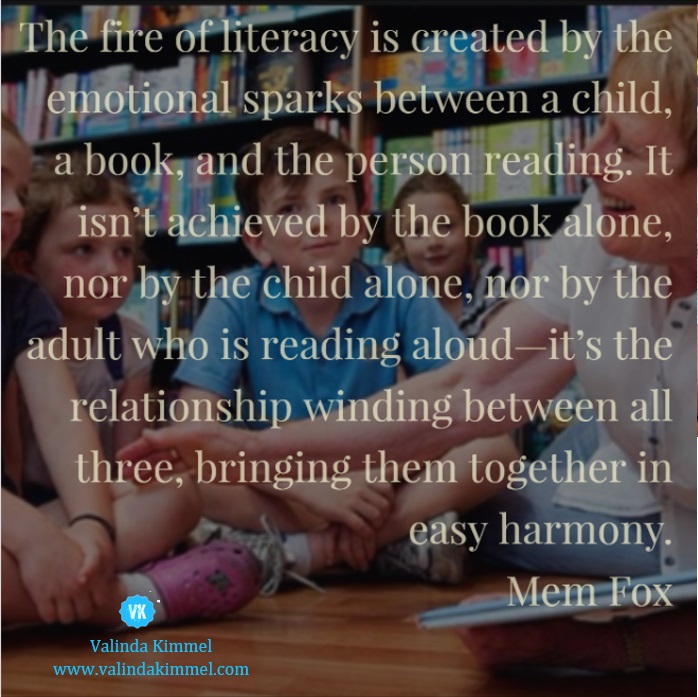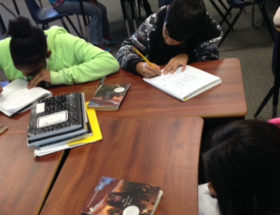“I wish I had known that last year,” whispered Imena.
Seated between Imena and Adi in the back of their 3rd grade classroom, after listening to their teacher read Rough Face Girl, I asked what life lessons they were considering. Imena said, “The lesson I take from Rough Face Girl is to be strong in myself.”
An impressive answer, I thought, for a young girl who was still learning to speak English. “Wow, Imena, that’s a really important lesson to learn.”
In the story, Rough Face Girl walks through the village as people throw insults her way. “‘Go home you ugly girl! You’ll never marry …’ But the Rough Face Girl had faith in herself and she had courage. She just kept walking right through the village.”
“I wish I had known that last year,” Imena went on. “I was at a different school, and I didn’t speak English very good. My teacher didn’t like me and the kids didn’t like me. One time, someone told I took money, but I didn’t. Really, I didn’t, but the whole year nobody ever believe me.”
I don’t suppose Rafe Martin wrote his beautifully illustrated Algonquin version of Cinderella knowing it would help Imena come to see a life lesson and powerful connection to a heartbreaking moment during her first year in America.
A few years ago, Tanny McGregor spent an afternoon in our district training center talking to a room full of teachers, coaches and campus administrators. She said (and I’m paraphrasing here), “When teachers read books aloud and readers respond to a text, a new story is created. Each person brings their own complex thinking to that text, unlike anyone else, and when that happens something beautiful unfolds.”
Tanny McG is right.
Imena’s experience is evidence. A whole new story was created through a simple read-aloud. When books are read aloud in a classroom full of kids, (no matter their age) something beautiful unfolds.
Bucket loads of beautiful, to be exact. When we’re committed to reading aloud thoughtful texts (consistently) it:
Builds Community
There’s nothing that compares to the shared experience of a book in a classroom. Donalyn Miller describes the daily read aloud perfectly, “I see caring people who embrace our differences and discover what we have in common. I think about laughing and crying together. My students and I will become a family–bonded by shared experiences in a community where everyone has value.”
This invitation to look and listen to compelling texts should be common practice in every classroom regardless of the age of students. I know secondary English (and English AP) teachers that read aloud to their students. And not just from the classics. Excerpts, picture books, speeches, editorials, short audio and video clips are all considered literacies; multiliteracies, if you will.
“Read aloud to your class once or twice a day, exposing children to numerous enjoyable stories, poems, and information books. Provide supportive conversations before, during and after reading.” (Roskos, Christie and Richgels, 2004)
In her book, Best Ever Literacy Survival Tips: 72 Lessons You Can’t Teach Without, Lori D. Oczkus encourages educators to include 5-7 read-alouds every day. She describes that the read-aloud sessions are not all like the traditional “sit down with a book” type of read aloud. Chapter 2 of her book suggests teachers use times like the few minutes kids are in line for lunch or waiting for recess to read a short poem, a pithy social media quote, a quick YouTube video; these are all literacies kids encounter and there’s much advanced planning to match these literacies perfectly to instruction throughout the day. Following Lori’s advice, couldn’t teachers also begin and end class sessions with a quick moment to read aloud texts all designed to teach, but also to confirm daily that students are members of the private, exclusive “club” that is their classroom community?

Models Proficient Reading
I cannot get enough of Burkins and Yaris book, Who’s Doing the Work?: How to Say Less so Students Can Do More. This summer I’m reading it again for the third time in a year. Burkins and Yaris start their book with a metaphor for the work of reading instruction in the classroom.
The dancing metaphor they use throughout the book starts in the beginning and is woven in and through each subsequent chapter. Imagine comparing reading to dance. When an audience member experiences a dance performance, they see the beauty of intentional movement, an expression of deep emotions through skillful moves expertly married to music in an unforgettable story narrated without words.
Such a performance inspires, provoking appreciation for, and understanding of, the expertise and power necessary to communicate in such an exquisite manner. It’s no hardship for the audience to easily understand the skill and proficiency required to execute the flawless choreography. The power of artistry in this field can both inspire and provoke when compelling performances are well-executed.
It’s the same with readers. When a committed teacher chooses books carefully to instruct, inspire, evoke feelings of empathy and action, students come to understand the skill required to engage readers with texts. Kids come to see and experience how readers read with accuracy, automaticity, expression, intonation, phrasing and prosody. In the interactive read-aloud where teachers stop at pivotal moments and invite thoughtful discussion matched to specific evidence from the selection, students also begin to understand the finer points of meaning-making.
Motivates Readers
This dance metaphor can also work to show us how to motivate students to try out the challenging work of reading on their own. In the “performance” readers see the beauty of the written word expressed in compelling ways as the narrative unfolds. When viewing choreographed dance, young and old alike are heard to express, “Oh, how I wish I could dance like that.”
The same is true for every child who listens to his teacher read aloud each day. There are moments when the student will most assuredly wish they too, could read in that way–proficiently and with the ability to move the audience to emotions that resonate. This is precisely why the read-aloud is so important.
When teachers consistently and faithfully read to their students, it acts as an agent for change. Change in heart, change in thinking, changes in an individual’s choices and actions. It can serve to teach empathy and compassion. Read-alouds can also act as a motivation for the most hesitant reader.
Closes the Achievement Gap
This heading should actually read “Closes the Opportunity Gap”. The cultural diversity in many classrooms today begs for read-aloud books that reflect the lives of the students in those classrooms. How in the world are all students to thoughtfully connect and engage when the only characters they see and hear about in books are white, middle class and speak English?
Shauntelle Modesta and Whitney Young wrote an article in 2014 for Children´s Literature and Reading Special Interest Group that speaks to this disconcerting issue.
“The effect of culturally relevant instruction in connection to academic success has been extensively studied in recent years (Banks, 2008; Gay, 2010; Howard, 2001; Irvine 2009; and Ladson Billings, 1992). Moreover, there is a strong connection between the two. African American children tend to be more successful when the instruction and literature is relevant and connects to their lives. African American students require pedagogy and curricula that is inclusive of their cultural knowledge base (Moje, 2007). African American students acknowledge and respond at a much higher level to teaching practices inclusive of their social backgrounds.”
Teachers must begin to develop high quality text sets that reflect the authentic cultural, racial and linguistic lives of all the students in their classrooms.
A word about high quality; books used for reading aloud must be evaluated on how well they provide language-rich, conceptually challenging, culturally relevant/authentic, unbiased selections that can also serve as mentor texts for writing and are able to captivate readers at their age and stage of development.
Provides Unforgettable Vocabulary
I’m a huge fan of the book, Bringing Words to Life by Beck, McKeown
- Point out the word on the page, prominently display the card with the word (and visual, if appropriate).
- Teachers contextualize the word for its role in the story. For example: In the well known children’s book, Corduroy, the teacher has chosen the word reluctant as one of the vocabulary words. The teacher will call attention to the word in its original context. “In the story, Corduroy, Lisa was reluctant to leave her teddy bear in the laundromat.”
- The word’s meaning is shared with students in a kid-friendly explanation. “Say the word – reluctant. Reluctant means you are not sure you want to do something. Lisa was not at all sure that she wanted to leave Corduroy at the laundromat.”
- Examples beyond the story are shared with students also. “Some kids are reluctant to try new foods. Or sometimes kids are reluctant to jump in the deep end of the pool for the first time.”
- Engage students in lively ways to utilize the new word immediately. Play games such as Applause, Applause. The teacher shares several sentences with the new word-some used correctly and others incorrectly. When students hear the word used correctly in the sentence, they clap. If not used correctly, they remain silent.
You can imagine if students are exposed to vocabulary lessons as the protocol above suggests, the new words they encounter are not easily forgotten and students can effortlessly begin to use those words in their own conversations and in their writing.
One important note: I strongly believe and advocate for books to be read aloud purely for enjoyment the first time. Lessons such as those described above would be best instructed during a subsequent reading.
Reading books aloud, as you can see, is a potent instructional practice. It’s also critical for binding hearts together in the learning community inside your classroom. As mentioned in the introduction to this six-part series–teaching reading is not for the faint of heart.
It’s work. It’s hard work. It’s incredibly important work.
Please return next week when I’ll discuss the critical role of instruction in phonological awareness and the alphabetic principle.











Great visual!
Thanks, Carolyn!
Loved every word of this blog, Valinda. Your well-crafted sentences and perfectly placed quotes capture the passion that emanates from your being. Thanks for being a champion of literacy!
Thank you, Tenille. I’m so glad you found your way to my site.